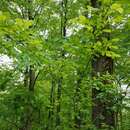Description
provided by eFloras
Shrubs or trees, deciduous, 2–5 m tall. Branchlets dark brown to reddish brown when young, grayish brown when old, initially white villous, glabrous when old, with scattered oblong or elliptic lenticels; buds ovoid, 2–4 mm, apex acute to shortly acuminate; scales brown, glabrous. Petiole 2–6 mm, villous; leaf blade obovate, oblong-obovate, or elliptic, 3–8 × 2–4 cm, herbaceous, veins 5–7 pairs, both surfaces initially white villous, glabrescent or subglabrous adaxially and villous only along veins abaxially, base cuneate, margin densely sharply serrate apically, apex caudate. Inflorescences terminal, corymbose, rarely umbellate, 2–5 × 3–6 cm, (5–)10–20- or more flowered; rachis and pedicels villous, with dense, oblong or elliptic small lenticels in fruit; bracts caducous, subulate or linear, 2–4 mm. Pedicel 1.5–2.5 cm. Flowers 7–12 mm. Hypanthium cupular, 2–3 mm, abaxially white villous or glabrous. Sepals triangular-ovate, 2–3 mm, apex obtuse. Petals white, suborbicular, 4–5 mm in diam., adaxially pilose near base, shortly clawed. Stamens 20, shorter than petals. Ovary densely white villous apically; styles 3, free from middle, glabrous. Fruit red or yellowish red, ellipsoid or ovoid, 8–10(–16) × 6–8(–11) mm, slightly pilose; sepals erect. Fl. Apr–May, fr. Aug–Sep.
- license
- cc-by-nc-sa-3.0
- copyright
- Missouri Botanical Garden, 4344 Shaw Boulevard, St. Louis, MO, 63110 USA
Distribution
provided by eFloras
Anhui, Fujian, Gansu, Guangdong, Guangxi, Guizhou, Hubei, Hunan, Jiangsu, Jiangxi, Shaanxi, Shandong, Sichuan, Yunnan, Zhejiang [Japan, Korea].
- license
- cc-by-nc-sa-3.0
- copyright
- Missouri Botanical Garden, 4344 Shaw Boulevard, St. Louis, MO, 63110 USA
Habitat
provided by eFloras
Slopes, forests, thickets, stream sides, roadsides, waste places; 100--1600 m.
- license
- cc-by-nc-sa-3.0
- copyright
- Missouri Botanical Garden, 4344 Shaw Boulevard, St. Louis, MO, 63110 USA
Photinia villosa: Brief Summary
provided by wikipedia EN
Photinia villosa is a species in the flowering plant family Rosaceae, with common names Christmas berry and oriental photinia. It is a shrub or small tree up to 5 metres (16 ft) tall, native to China, Japan, and Korea. This plant was recently introduced into the United States, likely as a landscaping or garden plant. It has escaped cultivation and has become increasingly invasive in northern New Jersey, eastern Pennsylvania, and parts of Virginia, New York and Connecticut.
- license
- cc-by-sa-3.0
- copyright
- Wikipedia authors and editors

